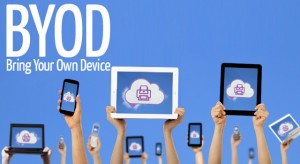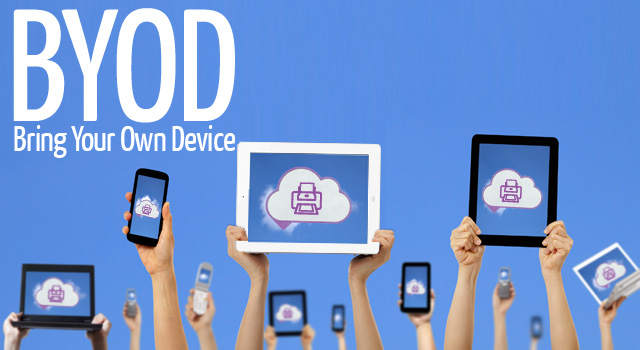The initial discussion paper from the ICT Excellence Group makes a number of proposals about the use of mobile devices and bring your own technology (BYOT). These are exciting ideas and the proposals of the group, of which I am a member, are guided by the needs of learners and teachers on the ground.
We need to keep apace with technology and the changing nature of its use by our young people. A major part of that is the use of learners own devices in school but I have a growing concern that access to connectivity in schools will be the next “lock-down”, replacing our frustrations with web filtering with frustrations relating to how we help learners get their devices connected.
A great many of our local authorities are moving forward with their plans to allow children to connect their own devices in school but many of these plans are routed in a desire to control access, monitor and even directly configure the devices that learners use.
What do learners want when they connect to a school network? Fast connectivity: they are not generally interested in accessing the local network, or the shared file store in school, or the corporate email service or the LAs exchange server. The leaner’s content is on-line, in Google Docs, DropBox, SkyDrive; In Facebook, Livemail/Hotmail, Youtube and Twitter. LAs are spending significant sums of money adding additional layers of complexity to their networks to support BYOT but do they really need to?
When I go to McDonalds and Starbucks, I can connect my device to the network, open a browser page, agree to the Ts&Cs and then get started. I don’t need to install a device profile, add a network security policy or promise my first born child to Scientology. I just get connected. This is the ease of use that we need in schools.
But LA systems are adding these layers of complexity (not the Scientology bit!) to device connectivity – its all a bit complicated and could potentially get in the way of effective learning. Mobile Device Management Systems may be the next major obstacle to effective use of technology in our schools. Are we really going to start the BYOT revolution by trying to police every device which enters a school? We tried that with filtering and look where that has taken us.
After all, in 2 to 3 years our learners will have 4G and access to data at any time on fast connections. Systems like MobileIron are all very good for managing devices which are owned by the local authority or school but should we even be considering forcing network policies on to devices which the LA doesn’t own?
I think BYOT comes with an inherent element of trust. We need to trust users will use the connectivity appropriately. To keep our corporate networks secure we connect mobile devices to a separate Virtual Network on our corporate network, one which is just configured to allow access to the Internet and protects the network resources/data/hardware from the perils of access from other systems.
If we don’t respond sensibly to the challenge of BYOT we will add significant cost and inconvenience to the experience of our users. When it comes to technology, keep it simple silly!


robfmac
@charlie_love agree x lots.
olliebray
RT @charlie_love: Mobile Devices: The next lock-down after filtering: http://t.co/RUyXIIHD
geodrew
RT @charlie_love: Mobile Devices: The next lock-down after filtering: http://t.co/RUyXIIHD
simfin
RT @charlie_love: Mobile Devices: The next lock-down after filtering: http://t.co/2WwNxsZZ
andyfield
RT @charlie_love: Mobile Devices: The next lock-down after filtering: http://t.co/RUyXIIHD
atstewart
RT @charlie_love: Mobile Devices: The next lock-down after filtering: http://t.co/RUyXIIHD
jgmwalsh
@charlie_love My school has just switched on wifi but only managed PC laptops and encrypted PC tablets can connect #whereisthevision
David Terron (@daveterron)
We were given a netbook brought with TESCO vouchers. Can’t use it on school wifi network as it was not supplied by the Council. We got it free (or would cost £250 at PC World). Via Council? £650! It’s all about the wee empires and the loss of control by people who just can’t (a) bear to let go and (b) have NO idea of the educational case for the various things we need.
Joe Wilson (@joecar)
I spent Friday in meetings at Caledonian university guest wifi access open and if I needed access to academic network eduroam available for log on too
Tony Sheppard
You trust users to use the devices appropriately? Whilst a certain amount of dealing with misuse is just behaviour management (the old problem of passing notes under the table or reading a comic behind a text book) there are a number of other issues where the school has a legal responsibility, including taking all reasonable and appropriate technical and organisational measures to protect data, as well as dealing with the risks associated with using the devices for bullying and so on.
Unfortunately, when people mention the above they are seen as blockers … rather than someone pointing out an essential requirement that has to be dealt with, not a barrier to be destroyed or ignored.
And yes … there will be times when learning will be compromised as a result, but that is no different to limitations within science labs, PE lessons and so on. You rarely see schools teaching martial arts in PE using edged weapons for pretty good reasons … even though the risk and focus needed to gain proficiency might not be a bad thing to consider doing, actually 😉
Charlie Love
Thanks for your comment and generally I’m in agreement with you that there does need to be a management framework which controls bandwidth and can deal with blocking of devices where users fail to meet the AUP (I like the idea of three strikes and you’re out). My point really is that this device management is hidden from the users, does not require them to specially configure their devices to connect to the network and does not force or push settings to their devices.
I know of LAs which won’t allow devices to connect to their networks unless the device is encrypted, that only allow devices which are windows based because of their authentication etc. etc. The evolving picture is of multiple strategies to do something very simple. Learners just need to be connected to a network which gives them Internet access.
What if we had an EduRoam type solution where users used their Glow credentials (Scotland’s National Intranet) to sign into the network? This would allow any Glow user to connect to any network in any school in the country. This already happens in the university sector so why not in schools?
Terry Freedman
Very interesting article. With regard to Tony’s point in particular, my view of e-safety in this regard is that, ultimately, you HAVE to trust students, if only because, as far as I can ascertain, it isn’t possible for schools to monitor and filter internet access via 3G or 4G, or texting. I think there are ways and means of involving the students in this, eg in the creation of a Responsible Use Policy — and a school whose case study I will be publishing soon has done just that. I think risk has to be managed and minimised, but I don’t think it can be eliminated. And even if could, that would only be a temporary state of affairs until something else came along.
Ian Simpson (@familysimpson)
It should be about managing behaviour not monitoring use. It boils down to a device being a resource, albeit one with a fantastic multitude of possibilities, that decision-makers do not fully understand and want to keep within their sphere of knowledge. Teachers (who should be treated as responsible, intelligent adults by the local authorities who employed them anyway) just need to be clear about what is acceptable and what isn’t and be consistent in their follow up BUT bear in mind that what is considered responsible use will change quickly as ICT-enabled education develops. For example, looking at current staff RUA (3 years old?) every member of staff who logs on and accesses a website where multimedia material is located is breaking the terms of that RUA. God forbid they want to use an educational game! This is even before the filtering issue.
Get the AUP/RUA right, follow up on indiscretions. Block the “naughties” and perhaps a few social media sites for staff. Revisit the AUP/RUA regularly. Trust the judgement of the staff you employed.
Too simple?